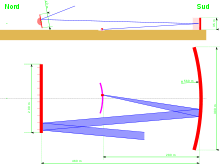Nançay radio telescope
| Nançay radio telescope | |
|---|---|
 Nançay radio telescope's primary mirror | |
| Location | Nançay, France |
| Coordinates | 47°23′N 2°12′E / 47.383°N 2.200°E |
| Altitude | 131 m |
| Wavelength | 9, 18 and 21 cm |
| Built | 1961–1965 |
| Telescope style | Transit |
| Collecting area | 8,000 square meters |
| Mounting | Kraus-type design |
The Nançay decimetric radio telescope (Le radiotélescope décimétrique de Nançay (NRT)[1]) is located in the small commune of Nançay, two hours' drive south of Paris, France. The radio telescope saw first light in 1965, after an inauguration by the then French president, Charles de Gaulle. It is one of the largest radio telescopes in the world.

The NRT is a transit instrument of the unusual Kraus-type design, with two mirrors. The flat, tilting primary mirror consists of ten panels, each 20 m long and 40 m (131 ft) high; it reflects radio waves towards the fixed secondary mirror 460 m to the south. The secondary mirror is shaped as a section of a sphere with a radius of 560 m: (1837 ft) it focuses the radio waves towards a mobile focal carriage 280 m to the north that contains antennas cooled by liquid helium to 20 K (−423.7 °F) and other receiving equipment. Both mirrors are covered with a metal mesh with square holes 12.5 mm on a side and a surface that is accurate to about 5 mm. The primary mirror tilts north-south to select any objects along the meridian, while the focal carriage moves east-west along a curved railroad track to follow objects across the sky. The NRT is capable of observing objects with a declination greater that −39°. Objects near the celestial equator can only be tracked for about an hour, but objects nearer the zenith can be tracked for longer. Observations are typically undertaken at frequencies of 1,400 MHz (equivalent to a wavelength of 21 cm), 1,660 MHz (18 cm) and 3,330 MHz (9 cm).
The central fifth of the NRT was constructed in 1961 as a proof of concept. The remainder was completed in 1964, and officially opened in 1965. Scientific observations started in 1967.
The Kraus-type design, named after Dr. John D. Kraus (1910–2004), was first used at Ohio State University's Big Ear telescope.
In 2010, a T-shaped array of 144 spiral antennas (1.6 km by 1.25 km), operating between wavelengths of 3 m and 30 m, was built next to the NRT as part of LOFAR.
References
External links
- Nançay Observatory (Official site, in English)
- Pôle des Étoiles touristic facilities: guided tours, planetarium shows, exhibits
- Google Maps